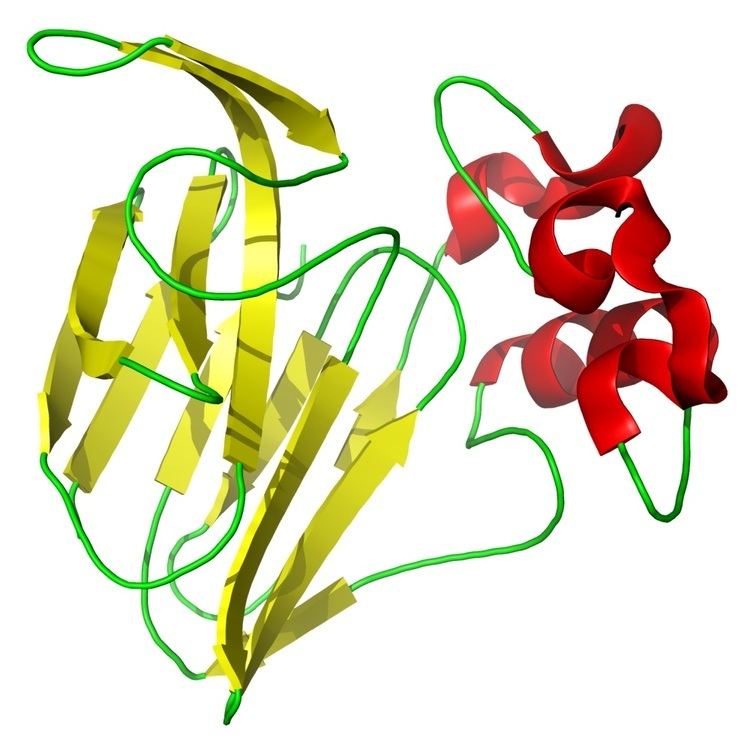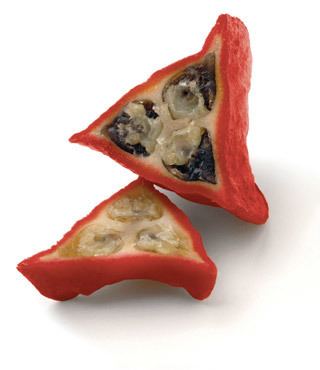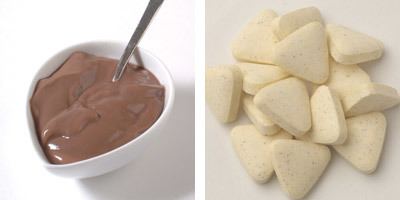Symbol Thaumatin InterPro IPR001938 PROSITE PDOC00286 | Pfam PF00314 SMART SM00205 SCOP 1thu | |
 | ||
Thaumatin b
Thaumatin is a low-calorie sweetener and flavour modifier. The protein is often used primarily for its flavour-modifying properties and not exclusively as a sweetener.
Contents
- Thaumatin b
- Food label secrets stevia and thaumatin
- Biological role
- Production
- Crystallization of thaumatin
- References

The thaumatins were first found as a mixture of proteins isolated from the katemfe fruit (Thaumatococcus daniellii Bennett) of west Africa. Some proteins in the thaumatin family of sweeteners are roughly 2000 times more potent than sugar. Although very sweet, thaumatin's taste is markedly different from sugar's. The sweetness of thaumatin builds very slowly. Perception lasts a long time, leaving a liquorice-like aftertaste at high usage levels. Thaumatin is highly water-soluble, stable to heating, and stable under acidic conditions.
Food label secrets stevia and thaumatin
Biological role

Thaumatin production is induced in katemfe in response to an attack upon the plant by viroid pathogens. Several members of the thaumatin protein family display significant in vitro inhibition of hyphal growth and sporulation by various fungi. The thaumatin protein is considered a prototype for a pathogen-response protein domain. This thaumatin domain has been found in species as diverse as rice and Caenorhabditis elegans. Thaumatins are pathogenesis-related (PR) proteins, which are induced by various agents ranging from ethylene to pathogens, and are structurally diverse and ubiquitous in plants: They include thaumatin, osmotin, tobacco major and minor PR proteins, alpha-amylase/trypsin inhibitor, and P21 and PWIR2 soybean and wheat leaf proteins. The proteins are involved in systematically acquired resistance and stress response in plants, although their precise role is unknown. Thaumatin is an intensely sweet-tasting protein (on a molar basis about 100,000 times as sweet as sucrose) found in the West African shrub Thaumatococcus daniellii: it is induced by attack by viroids, which are single-stranded unencapsulated RNA molecules that do not code for protein. The thaumatin protein I consists of a single polypeptide chain of 207 residues.

Like other PR proteins, thaumatin is predicted to have a mainly beta structure, with a high content of beta-turns and little helix. Tobacco cells exposed to gradually increased salt concentrations develop a greatly increased tolerance to salt, due to the expression of osmotin, a member of the PR protein family. Wheat plants attacked by barley powdery mildew express a PR protein (PWIR2), which results in resistance against that infection. The similarity between this PR protein and other PR proteins to the maize alpha-amylase/trypsin inhibitor has suggested PR proteins may act as some form of inhibitor.
The thaumatin-like proteins isolated from kiwi fruit or apple appear to have their allergenic properties minimally reduced by gastroduodenal digestive processes, but not by heating.
Production
Within West Africa, the katemfe fruit has been locally cultivated and used to flavour foods and beverages for some time. The fruit's seeds are encased in a membranous sac, or aril, that is the source of thaumatin. In the 1970s, Tate and Lyle began extracting thaumatin from the fruit. In 1990, researchers at Unilever reported the isolation and sequencing of the two principal proteins found in thaumatin, which they dubbed thaumatin I and thaumatin II. These researchers were also able to express thaumatin in genetically engineered bacteria.
Thaumatin has been approved as a sweetener in the European Union (E957), Israel, and Japan. In the United States, it is generally recognized as safe as a flavouring agent (FEMA GRAS 3732) but not as a sweetener.
Crystallization of thaumatin
Since thaumatin crystallizes rapidly and easily in the presence of tartrate ions, thaumatin-tartrate mixtures are frequently used as model systems to study protein crystallization. Interestingly, the solubility of thaumatin, its crystal habit, and mechanism of crystal formation are dependent upon the chirality of precipitant used. When crystallized with L- tartrate, thaumatin forms bipyramidal crystals and displays a solubility that increases with temperature; with D- and meso-tartrate, it forms stubby and prismatic crystals and displays a solubility that decreases with temperature. This suggests control of precipitant chirality may be an important factor in protein crystallization in general.
